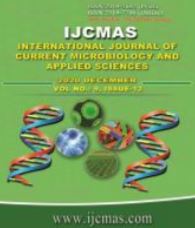


 National Academy of Agricultural Sciences (NAAS)
National Academy of Agricultural Sciences (NAAS)

|
PRINT ISSN : 2319-7692
Online ISSN : 2319-7706 Issues : 12 per year Publisher : Excellent Publishers Email : editorijcmas@gmail.com / submit@ijcmas.com Editor-in-chief: Dr.M.Prakash Index Copernicus ICV 2018: 95.39 NAAS RATING 2020: 5.38 |
A field experiment was conducted during Kharif seasons of 2018-19 and 2019-20 at N. E. Borlaug Crop Research Centre of Govind Ballabh Pant University of Agriculture & Technology, Pantnagar (Uttarakhand). The experiment was laid out in Split Plot Design with three replications having four planting methods as the main plot treatments viz; Conventional Sowing at 60 x 20 cm, Transplanting at 60 x 20 cm, 90 x 40 cm and 90 x 60 cm, and three nutrient management practices as Sub plot treatments viz; 100 % RDF (12:32:16 NPK fertilizer @ 150 kg ha-1), Vermicompost at 5 ton ha-1 and 50% RDF + Vermicompost at 2.5 ton ha-1. The test variety of used was ‘Pant Arhar 291’. The growth, yield, soil quality and economics of pigeonpea crop were found to be significantly influenced by various planting methods and nutrient management practices. Transplanting at 90 x 40 cm recorded the highest grain yield during both the years due to relatively higher plant population per unit area. The grain yield was 32.6 and 34.7 % higher over that of the Conventional Sowing at 60 x 20 cm during 2018-19 and 2019-20, respectively. The combination of inorganic and organic sources led to significantly better microbial population along during both the years. The maximum gross returns were obtained in case of Transplanting at 90 x 40 cm spacing. Among the nutrient management practices, the gross returns were highest with 50% RDF + Vermicompost at 2.5 ton ha-1. Thus for sustained productivity of pigeon pea, it can be transplanted at 90 x 40 cm spacing and for nutrient application integration of 50% RDF + Vermicompost at 2.5 ton ha-1 could be taken as the most promising practices for System of Pigeonpea Intensification.
 |
 |
 |
 |
 |